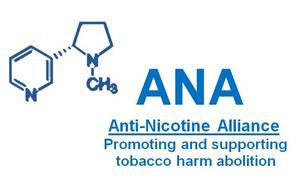Anti-Nicotine Alliance
You will not have not heard of this organisation because it’s still in the process being set up. When the Board of Trustees is established – Dr Gabriel Symonds has volunteered to be the honorary Chairman – we intend to apply to the UK Charities Commission for registration.
The main aim of ANA is to educate the public about the dangers of nicotine addiction through alternative nicotine-delivery devices. That is, alternative to combustible tobacco products, generally known as cigarettes or cancer sticks. These alternatives include e-cigarettes, ‘heat-not-burn’ products such as IQOS, Ploom, ‘glo’ and the like, and Juul. For economy of words all these products will be included in the term e-cigarettes in this post.
The fact that an organisation like the ANA is needed is attested to by widespread misunderstanding of what e-cigarettes are and do to those who use them. This misunderstanding extends from government supported quit smoking clinics to the existence, even, of a Registered Charity, the so-called New Nicotine Alliance (NNA).
NNA has set out a Position Statement on their website. This is a collection of assertions about the alleged benefits of vaping which they attempt to justify by cherry-picked references from the scientific literature.
We’ll examine their main points.
Vaping is safer than smoking.
Vaping is at least 95 per cent less risky than smoking. The scientific consensus is that vaping (using e-cigarettes) is substantially less harmful than smoking. No credible expert would disagree with that opinion.
Is the expertise of WHO credible enough for them?
[E-cigarettes] are unlikely to be harmless, and long-term use is expected to increase the risk of chronic obstructive pulmonary disease, lung cancer, and possibly cardiovascular disease as well as some other diseases also associated with smoking. The magnitude of these risks is likely to be smaller than from tobacco smoke although no specific figure about how much “safer” the use of [e-cigarettes] is compared to smoking can be given any scientific credibility at this time. (Emphasis added.)
Source: WHO Framework Convention on Tobacco Control, August 2016: Electronic Nicotine Delivery Systems and Electronic Non-Nicotine Delivery Systems.
Back to NNA Position Statement.
Why do people use e-cigarettes?
The vast majority of people use e-cigarettes as a way of stopping or reducing smoking.
Vaping is seen by vapers as a safer alternative to smoking. There are (sic) a variety of reasons why people continue to vape, including that they find vaping pleasurable, there’s a variety of flavours, that it does not cause harm to bystanders, it does not smell of burnt tobacco, and they like the feel of holding and using an e-cigarette.
How can they speak for the vast majority of people who use e-cigarettes? This is merely the view of NNA. Further, it’s misleading to talk of e-cigarettes as a way of stopping or reducing smoking. The way to stop or reduce smoking is just to do it. Incidentally, merely reducing smoking will do very little or nothing for a smoker’s health.
Then they say it’s pleasurable. What, exactly, is pleasurable about sucking a nicotine-laden aerosol into your lungs hundreds of times every day? And to say people like the feel of holding and using an e-cigarette as a reason for vaping is trivialising the matter.
What is good about vaping?
Vaping has many benefits – it is a healthier, pleasurable alternative to smoking.
We are now on dangerous ground. What benefits, exactly, does vaping have? To say that vaping is healthier implies it has health benefits. This is misleading. What they seem to be saying is that they believe vaping is less unhealthy than smoking cigarettes.
And as a bonus to the dubious activity of vaping, they think it’s pleasurable as well. You can choose from a myriad synthetic flavours to experience the joys of different tastes by drawing e-cigarette vapour into your mouth as it passes down to the deepest recesses of your lungs.
There are many pleasurable alternatives to smoking, including not smoking or using nicotine at all. An alternative to smoking doesn’t have to be an activity whereby you continue to suck poison into your lungs. You could take up yoga or stamp collecting if you want something to do instead of smoking. Or you could just get on with your life.
The Pleasure Principle
A vital part of the successful transition from smoking to vaping is finding a combination of products and technique that suits the individual – that brings them pleasure.
I have written previously about NNA’s incorrect reference to Freud’s concept of the Pleasure Principle. This is obvious nonsense. What normal human activity do people engage in hundreds of times every day for pleasure and get in a panic if they can’t? E-cigarette use is nothing to do with pleasure and everything to do with drug (nicotine) addiction.
So what does NNA have to say about addiction?
Nicotine addiction
Using nicotine is no worse than drinking coffee, says Professor John Britton – NNA agrees.
Nicotine itself is not a particularly hazardous drug. The nicotine in e-cigarettes poses no more danger than drinking a few coffees on a daily basis, and no-one would seek to ban, or limit, adults’ enjoyment of their coffee.
This is a specious argument and what Professor Britton says is merely his opinion. Caffeine dependence and abuse are rare. With coffee drinking you can take it or leave it. Vapers, on the on the other hand, feel compelled to suck on their e-cigarette device repeatedly throughout the day and get in a panic if they can’t.
This is borne out by what NNA says about vaping bans in public places.
We do not support the legal prohibition of e-cigarette use in public spaces, enclosed or outdoors.
Of course they don’t support such a prohibition. But why do vapers feel compelled to vape even in public places? Why can’t they wait till they’re back home to do it? The answer is because they have a need to vape continually – this is addictive behaviour.
Now we come to the crux of the matter.
Is addiction to nicotine in the absence of harm a problem?
In the absence of physical harm to either the user or to others, the issue of whether nicotine addiction is a problem is more of a moral or psychological issue.
This amounts to an indirect admission by NNA that e-cigarette use is nicotine addiction. But the statement, ‘the absence of physical harm [from vaping] to either the user or to others’, cannot be allowed to pass unchallenged.
It’s an unproven assertion. There are many scientific references to the actual or potential harm of vaping, both to vapers and bystanders.
Why was NNA set up anyway? To allow vapers to indulge in some new-fangled harmless pleasure? To assist smokers to discover a less harmful – but almost certainly a still harmful – way of continuing to be addicted to nicotine?
Perhaps one moral or psychological aspect of vaping that NNA hasn’t considered, or doesn’t want to consider, is that if vaping were allowed everywhere in public, the spectacle of people inhaling poison into their lungs would be distasteful or even upsetting for non-vapers. And what effect will it have on children? You can imagine the following conversation:
Child: Mummy, what’s that man doing?
Mother: He’s vaping.
Child: What’s vaping?
Mother: He’s sucking vapour into his lungs.
Child: Mummy, why is he sucking vapour into his lungs?
Mother: I don’t know…I suppose he likes it.
Child: Mummy, can I try it please?
Mother: (Horrified) No! That’s only for grown-ups!
Fortunately, it’s easy to quit smoking and nicotine use in any form. The Symonds Method can show you how.
Text © Gabriel Symonds

